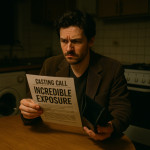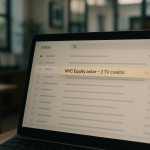Remote table reads: running cross-border collaborations that impress producers
Remote table reads can turn an ordinary screenplay draft into a hot-property package—provided the session sounds clean, stays on schedule and gives producers the decisive “green-light” feeling. Follow this practical roadmap to organise virtual readings that cross borders smoothly, delight actors and, most importantly, wow the decision-makers holding the purse strings.
Why remote table reads have become a producer favourite

Picture a cross-continental mosaic of performers—an LA comedian riffing off a London stage veteran while a Mumbai voice actor punctuates the pacing and a Toronto narrator grounds the scene. That visual alone sparks a producer's imagination, but what truly seals the deal is hearing broadcast-quality audio pour through headphones with zero stutter. In a single 90-minute session, decision-makers capture a living proof of concept: tonal range, cultural adaptability, marketable synergy and schedule feasibility, all without booking a single airline ticket. When the credits finally roll on the meeting, the question is no longer “Does this script play overseas?” but “How fast can we clear the next financing milestone?” Such clarity explains the meteoric rise of remote table reads across development slates worldwide.
Financiers no longer wait for in-person workshops to gauge a script's potential. A crisp remote table read lets them:
- Hear chemistry between an international cast before travel budgets kick in.
- Collect timestamped feedback minutes after the call ends.
- Trim weeks off development calendars by iterating drafts in parallel.
That speed explains why directories such as Artfolio's collaboration-ready actor listings report a 37 % rise in “remote read” tags since 2023.
Build an audio-centred tech stack producers trust
Pick a platform purpose-built for dialogue
Video is useful for reactions, but producers judge performance on vocal nuance first. Options like Riverside, Cleanfeed or Source-Connect Pro deliver uncompressed 48 kHz audio while keeping latency under 50 ms. Embed a backup Zoom call with cameras muted to catch body language without compromising sound.
Microphone policies every invite must spell out
- Require XLR or USB mics with cardioid pickup patterns. Laptop mics are an immediate red flag.
- Send a PDF of gain and distance guidelines (20 cm rule) two days before the read.
- Schedule a five-minute level check per actor on joining.
Need a refresher on presentation basics? Our article on crafting an online profile that aces the five-second casting scan covers camera framing and lighting that carry over to table reads.
Time-zone choreography: turning global calendars into one smooth call
Use UTC +00 as the single reference in all invites to avoid AM/PM mishaps. Then apply the following benchmark windows:
| Region | Ideal start time (local) | Reason |
|---|---|---|
| Los Angeles | 08:00 | Before other meetings fill the day |
| New York | 11:00 | Boosts alertness after commute |
| London | 16:00 | Still inside office hours, post-lunch slump avoided |
| Mumbai | 20:30 | Late but pre-dinner; actors free of day jobs |
| Sydney | 02:00 (next day) | Only if Australia hosts minority of cast |
When the spread becomes brutal—say, Los Angeles and Sydney—split the read in two acts on consecutive days. Producers appreciate the respect this shows for vocal freshness.
Net latency: knowing when it matters
Below 80 ms, actors usually overlap lines naturally. Above 150 ms, comedic pacing dies. Recent Speedtest Global Index data shows typical fixed-broadband latency in major production hubs:
Source : Speedtest Global Index, Jan 2024
Tips when latency creeps over 120 ms:
- Route every feed through the same low-latency server region, even if that means actors connect farther.
- Ask narrators to add micro-pauses before paragraphs to avoid accidental crosstalk.
Etiquette that keeps producers listening, not policing
Table read house rules
- Mic discipline: mute only during off-scenes. Over-muting kills spontaneity.
- Script version lock: attach the PDF in the calendar invite and label any subsequent revision “v2-date”.
- Chat channel: use a dedicated Slack thread for line notes so the voice channel stays clear.
Performance flow hacks
- Assign a virtual stage manager to cue scene numbers. That prevents the director from multitasking.
- Drop a 10-second ambience track between acts; it resets attention spans.
- Give producers “listening roles”—e.g., allocate one to monitor emotional stakes—so they stay engaged instead of checking emails.
For outreach before and after the read, mirror the courtesy guidelines in this guide to engaging recruiters without spamming.
Security and backup: the invisible layer producers notice subconsciously
Script protection
Watermark each PDF with the participant's email. Automate expiry 24 hours after the read via a DRM tool like Locklizard. For NDA management, adapt the template from our trust-badge credit article.
Redundant recordings
Record ISO tracks locally with OBS or QuickTime while the platform captures a cloud mix. That duality impresses post-production-minded producers.
Case study: The 48-hour Paris–Toronto–Mumbai read that sealed financing
Writer-director Léa D. needed proof her dark comedy worked across cultures. Here's how her team pulled it off:
- Day 1 – 09:00 UTC: First act, English script, Paris & Toronto actors live. Mumbai group received the video within two hours.
- Day 1 – 18:00 UTC: Mumbai recorded Hindi punch-up suggestions asynchronously.
- Day 2 – 12:00 UTC: Full ensemble gathered for the final act with revisions live-swapped in Google Docs.
- Outcome: Producer forwarded the session to financiers who green-lit a €1.2 M development slate.
Quiz: Are your remote table reads producer-ready?
FAQ
- Do producers expect cameras on during a remote read?
- Yes. While audio takes priority, visible reactions help assess chemistry. Position the webcam at eye level and maintain soft front lighting.
- How many pages can realistically be covered in one virtual session?
- Plan for 60–70 scripted pages in a two-hour block, allowing brief pauses for notes and comfort breaks.
- Should stage directions be read aloud?
- Keep them concise—location and vital action only. Excessive description drags pace and distracts listeners.
- Can non-union actors join a remote table read for a union project?
- Usually yes, if the read is classified as development, not a paid rehearsal. Confirm with the production's labour counsel first.
- What's the best file format for sending revised pages rapidly?
- A locked Google Docs link with “suggesting” mode enables instant viewing without extra downloads, then export a timestamped PDF for archives.
Take-away: Producers crave clarity and momentum. Nail those two elements and your remote table read becomes a green-light machine.
Ready to assemble your dream cast? Browse time-zone-sorted profiles and lock talent faster via our guide to navigating online casting events.











